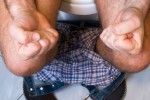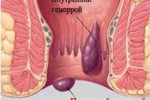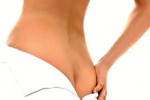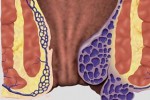In various medical directories have their own interpretation of hemorrhoids, but all of them are based on the condition of hemorrhoids catch.
therefore, According to this classification, the following types of hemorrhoids: interior, the outer or external, chronic, acute, combined or mixed.
internal hemorrhoids

at internal hemorrhoid there is an expansion of the lower number of vessels and veins of the rectum, under the skin mucous membranes begin to form hemorrhoids. The reason for this phenomenon is the stagnation of blood in the pelvic organs.
The end of the nerve bundles rectal mucosa do not respond to pain, so for a long time, it can occur almost asymptomatic. But under certain circumstances,, related risk factors (constipation, weightlifting, childbirth, etc.. P.), a person begins to experience the following symptoms:
- pain in the rectal area;
- foreign body sensation;
- discomfort during bowel movements;
- of bleeding during bowel movements and loss of internal hemorrhoids.
The outer or external hemorrhoids
Manifestation external hemorrhoids characterized performance hemorrhoids outside the anus. External hemorrhoids can show their symptoms and before, as the hemorrhoids grow in size:
- the appearance of seals around the anus, which vary in size and easily felt with the fingers;
- discharge of blood during bowel movements, but not so often, both at the inner form of the disease;
- itch, burning, irritation;
- pain, if bowel movement is accompanied by constipation.
Besides, when this form of hemorrhoids, often occur anal fissures, which are the cause of bleeding. Bloody discharge will leave their mark not only on toilet paper, but also trickle to run for the toilet during and after the process of defecation. The appearance of symptoms of external hemorrhoids always indicates the beginning of the disease exacerbation, which then goes into remission. External hemorrhoids shall entail the risk of complications and comorbidities, which include the thrombosis of hemorrhoids.

Photos external and internal hemorrhoids.
acute hemorrhoids
There are three stages of acute hemorrhoids:
- Thrombosis of hemorrhoids is not accompanied by inflammation, contains minor pain, which may increase after long sitting, weight lifting, adoption of an acute, pickled food, alcoholic beverages and so on. P. It is also noted itching, burning, discomfort after defecation.
- When hemorrhoids develops into second step, intensity of pain is greatly enhanced, nodes increase in size and they are almost impossible to study using fingers, there are spasms of the anal sphincter.
- It manifests a pronounced inflammation of hemorrhoids, as a result, the whole area around the rectal channel becomes congested and infiltrated. Often, nodes pinched, acquire blue-purple color, not subject to reposition and form dense areas of necrosis. untimely treatment can lead to the development of acute abscess, excessive bleeding, edema anal and t. d.
chronic hemorrhoids
This form of the disease may be months, and even years is in stage remission (attenuation), so the disease is steadily, without obvious symptoms change, if there is no heavy bleeding. Basically, the patient feels stable, but not excluded cases of gradual deterioration of health.
There are four steps:
- hemorrhoids are under the skin fold;
- loss of hemorrhoids during bowel movements and independent of their reduction;
- dropping nodes reduce a hands;
- hemorrhoids fall straining, cixanii, weight lifting, moreover, they do not lend themselves to reposition hands
Combined (mixed) hemorrhoids
In this type of hemorrhoids, hemorrhoids can be located outside, and inside the rectal canal. Since the disease develops gradually, it is very difficult to detect at an early stage, so is heavy chronic with alternating periods of exacerbation and remission of internal or external hemorrhoids. Person, This hemorrhoid sufferers, experiencing constant feeling of discomfort, accompanied by all the symptoms of the disease. disease occurs during a very difficult, to form a thrombus hemorrhoids, inflammatory processes and general deterioration of the organism.
It should also be aware, that any kind of hemorrhoid is treatable. After diagnosing the disease and confirm the diagnosis, proctologist individually assigns a method of treatment and make appropriate recommendations. Techniques and methods of treatment depend on the stage of development of the disease. Modern medicine uses: conservative, minimally invasive, surgical and People's method treatment.











